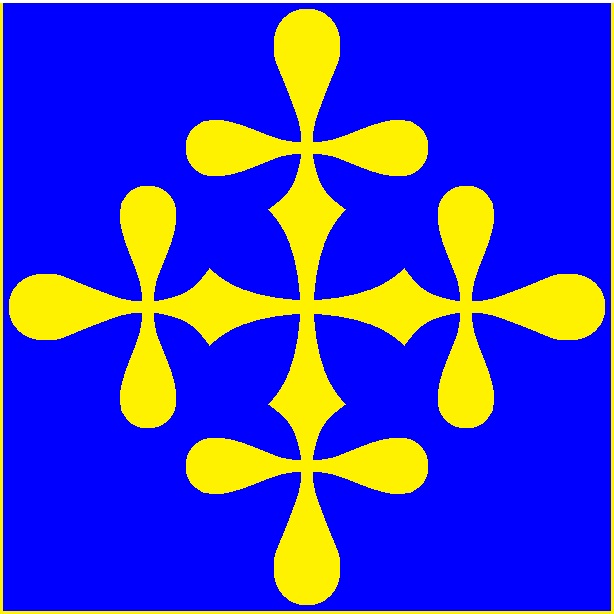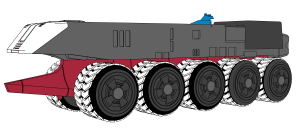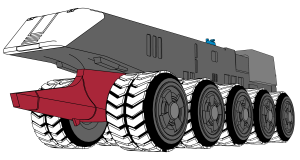 |  | ||||||||
USS DAEDALUS was riding at anchor the day of the SDF-1's commissioning. History tells us what happened that day. Later on the REF, in it's search for a simple, reliable Mecha transport of non-combat operations
Amongst other noteworthy changes is the main deck. The original specification had 2 towers, joined by a "bridge" across the hull. The PLANET MASTER has a mono-unit main superstructure, with two smaller superstructures, one a smaller superstructure just port side of the main superstructure, the other a second bridge used only for backing up when planet side or backing down during docking maneuvers in space. Though the two smaller superstructures are original design, the larger main superstructure was borrowed from the PROMETHEUS-Class, due to it's more aerodynamic design and structural stability. Another noteworthy change is the Mecha load. The original design carried 165 Destroids. The PLANET MASTER carries over five TIMES that many. This is due to three main factors: Mecha Size, Hull Size, and Deck Layout. The Mecha itself is smaller. This alone can account for over a 250% increase in Mecha load. Next the hull is larger. This accounts for nearly a 200% increase in Mecha load. Finally the old "stall" system was dropped and the more traditional cargo loading system of "stuff it in there" increased capacity over 250%. Gone are the internal ramps, replaced by simple elevators, and the stalls, which had been mostly to hold the Mecha in place when not in use, were replaced by twin poles, one that swings down from the overhead, and another that swings up from the deck to meet it to which the Mecha can be clamped. For long-term storage, a cargo net can also be wrapped around both the Mecha and the Mecha Stanchion, holding it that much more securely in place. As a final measure the cargo net can be sprayed with a chemical related to "Buckeyballs" that when dried hardens to a near-steel toughness but can be dissolved with a counter-agent. This chemical is also used as a field patch for damaged Mecha (disingenuously as the brand name "Steel Patch"), and aboard ships as a hull and pipe patch reinforcement. A third major change is armaments- The BEACHMASTER-Class had no integral weapons systems. Not so the second run of PLANET MASTER. The first block didn't have any as this was thought to be wasteful of deck space but the error of this decision was corrected in the second block. Orignally these include 03 gun turrets, each wielding 6 of the 20 inch (40cm) autocannnons of MAC II/III fame, a stern-mounted MRM launcher (actually the Porcupine Missile System of SDF-1 fame, though doctrine hold this is ONLY loaded with MRM's), and forward mounted LRM launchers (simply the old torpedo tubes used to fire LRM's; Typically, Proton torpedoes are used). Of the first run of 2 ships one (UES DOUGLAS MUNROE (AS-216)) was retro-fitted to an armed version. The other (UES CHESTER PULLER (AS-217)) was not. Still the PLANET MASTER is NOT a front line combat vessel. It's primary mission is to transport spare Mecha to the fleet, and this job it does well. Up to 500 REF Destroids or VT's, or 300 RDF era Destroids/VT's, can be stored on these vessels (less the MAC II/III). After the Tirol Assault, the need for more was quickly realized, and additional vessels were ordered. A total of 200 such vessels were eventually built. About 20 of them were unarmed versions for use by non-combat units, and another 20 converted to Artillery Battalion models (larger elevators for HAS I/II's). PLANET MASTERS can be thought of as a combination of cargo ships, LST's, and light frigates of the fleet. The REF is constantly redesigning the ships to simplify construction; The end goal is to be able to build a ship from raw steel and parts to finished ship in 2 weeks, and with Block 71 an experiment was conducted using HAYES-Class Carrier superstructures and removing any bends in the hull not absolutely necessary to ship function, wheels, and M-14/M-16 turrets. They were able to reduce construction to 2 weeks and 6 days, but in man hours had the build time down to 13 days. The decision was then made by a joint Council select committee, which decided that the additional 3 days needed to retain the wheels and turrets was worth the additional cost but the the Hayes Tower and hull form would stay, amounting to 16 days build time. Name: RDF and REF PLANET MASTER-Class Assault Shuttle Model Type: Assault Shuttle Crew: Because of the HUGE size of a PLANET MASTER'S crew, it has been broken down into it's component parts. Exact numbers will vary over time: Officers: 1 Commander (CO), 1 Lt. Commander (XO), 1 Lt. (Ops Boss), and about 50 junior officers Warrant Officers: 06 (02 Bosuns, 03 Engineers, 01 Corpsman) Enlisted: About 2,400 Note: Enlisted numbers, more so than officers, will vary over time as people advance and transfer. Combat Troops: Up to 250 Mecha pilots can be carried if necessary. Passengers: Up to 2,500 troops can be carried if no Mecha is on board; This is usually part of an evacuation. MDC By Location: | |||||||||
| Main Hull- Retractable Wheels (26)- Bow Door- Mecha Launch Ramp- Launch Ramp Hydraulics- Main Superstructure- Aft Wheelhouse- Main Thrusters (6)- Side Hull Sliding Doors (4)- LRM Launch Tubes (6)- | 3,000 300 each 1500 120 600 400 300 800 500 each 200 each | MRM Launcher (main deck)- Retractable Gun Turrets (3)- Main Guns (18)- * Hull per 165 square ft area- * Internal Doors, Hatches, Scuttles, and Bulkheads per 40 square ft area- ** Amidships third of hull- *** Main Engine (stern hull)- **** Auxiliary Engines- | 200 400 each 150 each 500 100 1,000 1,000 1,000 | ||||||
| Notes: * Depleting the MDC of a specific area of the ship will breech the hull/bulkhead/etc, but will only give access to that area. A second reinforced hull must be penetrated to gain access to the ship itself. Reinforced hulls have the same MDC as the outer hull and do NOT count as interior bulkheads. ** Depleting the MDC of the amidships third of the ship will completely shut her down (as the reactor goes off-line). Nothing will operate, including life support, gravity control, communications; Nothing except engines and a few VERY BASIC damage control systems. The engines can be jury rigged in about 20 minutes to supply basic power; Life support only. Fortunately, this is a condition the crew trains for, and is ready if it happens. *** Depleting the MDC of the Main Engines in the rear of the vessel will severely impair it, leaving only the Auxiliary Engines. **** Depleting both the Main AND Auxiliary Engines will completely immobilize the ship, setting it adrift in space or crashing to a planet if too far into it's gravity well. The loss of Auxiliary Engines alone will NOT impair the vessels flight. While losing both the engines will immobilize the vessel, all other internal and weapons systems function normally. Speed and Statistical Data: | |||||||||
| Hover Over Land/Water : 500 MPH safely; Mach 08 is possible only long enough to breech an atmosphere if absolutely necessary (grav pods are the preferred method of flight, but will not be able to breech a gravity well on it's own). Range Over Land/Water: Unlimited Flying: 500 MPH; Operational speed: 100 MPH Operational Ceiling: 15,000 feet before the ship must take up orbit in space. Surfaced On The Water: 25 knots safely Underwater: 40 knots safely Maximum Depth: 15,000 feet (2.5 nautical miles) Maximum Dive Time: 30 Months Space: Main Drives: Factor 16 Auxiliary Engines: 0.16 Light | Clearance: 257 ft Beam: 230 ft (70.10 m) Length: 1,650 ft (50.30 m) Weight: 139,150 tons. Cargo: Mecha Power Plant: Reflex heat pile system Gravity Control: Internal Flight Systems: Grav Pods Cost and Availability: 4.1 billion each; Every 06 months. Black Market Cost and Availability: Would cost around 40 billion each; Not yet available, and not likely to ever be, though individual groups have built a few for themselves. | ||||||||
| Weapons Systems: Beginning in in 2580, the UGC ordered the fleet to modernize to a single standard. With this standardization came an overhaul to the PLANET MASTERS that were then in service, but these were delayed to allow new ships coming off the lines to be modernized instead. | |||||||||
| 1. L-22 Rail Launchers (6): As a mounted ships gun the L-22 is fed by a continuous 'belt' of ammo via a conveyor belt. The guns are arranged 2 strictly forward (just under the launch ramp; can not be used when the ramp is deployed), one on the port and starboard side just below the bridge, one topside just forward of the bridge, and one aft, just above the thrusters. Like it's ground-based counterpart, the L-22 is radar controlled, manually commanded, and supported by off-site radar designators (including F/A-18 Hornet Fighters). Designed for MRM's. Purpose: Heavy Assault. Damage and Range: Varies by type used. Rate Of Fire: Once per melee. Payload: 1,000 MRMs can be carried if no cargo is carried (frigate configuration), but about 250 is normal. Bonus: Either triples the normal range of the missile OR doubles it and adds +3 to strike. 2. L-08 Rail Launchers: The L-08 rail launcher is fed from a belt attaching to the right side of the gun. The system is radar controlled, but manually fired and designed for Mini-Missile's. Purpose: Heavy Assault. Weight: 2 tons Damage and Range: Varies by type used. Rate Of Fire: Per gunner's attacks per melee. Payload: 10 per magazine (loads from the right side). Bonus: Either quadruples the normal range of the missile OR triples it and adds +3 to strike. | 3. Mecha And Other Vehicles: Exact numbers will vary based on mission, but is general as listed here. Non-Combat Ground Vehicles= 50 Total Combat Ground Vehicles= 50 Total Non-Combat Aircraft= 0 Total Combat Aircraft= 05 Total (mostly infantry support helicopters) Power Armors= Approximately 1,500 Total Zulu-1 Destroids= Approximately 1,500 total VAF-6 Shadow Alphas= 500 Total RDF era mecha take up more space, and thus the numbers will be reduced. | ||||||||
| General Cargo Arrangement: | |||||||||
| Deck One: When used as a box carrier this deck is loaded with power armor. When used as an assault carrier this deck is loaded with combat aircraft. Deck Two And Three: Mixed; Destroids, Veritechs, Guardians, and Cyclones. Deck Four (Assault Deck): Destoids and power armor. These will be ready to use in either Box or Assault mission. Deck Five: Spare parts only. Some machining rooms exist down here, where limited repairs can be made. As noted before, this inventory is subject to change at any time, based on the needs of the REF as a whole. | |||||||||
| Features: | |||||||||
|
| ||||||||


